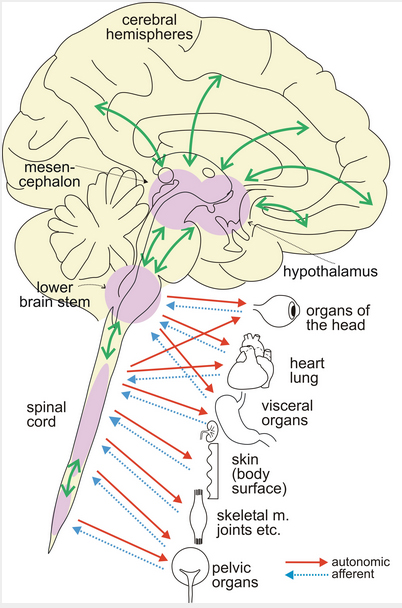Wednesday, 11 October 2017
The Brain and Body Are Really One, Especially When It Comes to Emotions
 In April 2017, while preparing a lecture for a course on embodied cognition that I teach in French at UPop Montréal, I had to refresh my memory about the major communication pathways between the brain and the rest of the body, and one thing that struck me was just how many of these pathways there are!
In April 2017, while preparing a lecture for a course on embodied cognition that I teach in French at UPop Montréal, I had to refresh my memory about the major communication pathways between the brain and the rest of the body, and one thing that struck me was just how many of these pathways there are!
I won’t talk here about the communication pathways that are part of the hormonal and immune systems. Instead, I’ll focus on the pathways in the nervous system alone. The central nervous system (the brain and the spinal cord) is connected to the rest of the body by the peripheral nervous system, which in turn is divided into the somatic and autonomic nervous systems. The somatic nervous system consists of the sensory nerves that carry information to the brain and the voluntary motor nerves that convey instructions from the brain to the body’s muscles. The autonomic nervous system also carries information in these two directions, to regulate the functioning of the body’s internal organs (such as the intestines, heart, and lungs). The autonomic nervous system is divided into the sympathetic and parasympathetic nervous systems. The neural pathways of the sympathetic nervous system orchestrate the flight-or-fight response to stress, while those of the parasympathetic nervous control recovery from this response.
You can find all of the above information in any book about the human nervous system. This traditional kind of functional description does of course help us to better understand the interactions between the human brain, the human body, and the outside world. But it also has the drawback of implying that the human nervous system was designed as an engineer might have done it, planning each function to provide an optimal solution to a particular problem. But that’s not how it really happened. As Nobel Prize-winning biologist François Jacob described it in his 1981 book Le jeu des possibles, “[translation] Evolution does not create something new out of nothing: it works with what already exists. The process of natural selection does not work like an engineer; it works like an artist or artisan who has no fixed plan but takes all the materials at hand and turns them into something.”
That’s why I like to discuss embodied cognition from an evolutionary perspective. To consider the importance of our bodies in our cognitive processes, we can start with the problem of the anchoring of meaning: why do some things acquire a positive or negative meaning for a given organism? The reason, as we can quickly realize from the classic example of bacteria moving up a sucrose gradient, is that the organism has a body. That body has a certain shape, certain sensory organs, and certain enzymes in its metabolism, all of which give it access to certain resources that enable it to “maintain its structure”, as Henri Laborit would say. Like any living system, this embodied organism is subject to entropy (the second law of thermodynamics), a process that tends constantly to disorganize and destroy it. The organism’s survival thus depends on behaviours of approaching resources that are useful to it—resources that its nervous system, if even slightly complex, will very quickly associate with “positive values”. Conversely, when the organism faces situations that are dangerous, that might injure or kill it, and that it hence associates with “negative values”, it must either avoid them by fleeing or, if it has no choice, fight them.
In other words, we come back to the role of the sympathetic nervous system, but this time with an ultimate, evolutionary explanation for its presence, and not just a simplistic model that treats it like a mechanism designed by an engineer.
Like cognitions, emotions are intimately connected with the body and originate in “values” that are positive or negative for the animal in question. The history of the study of emotions is full of examples of this vacillation between the relative importance of the brain and the rest of the body. From the Papez circuit to MacLean’s limbic system to the strong influences that the hypothalamus and the amygdala exert on the rest of the body, we have come now to an integrated, large-scale conception of cortical and subcortical circuits that regulate bodily processes in complex ways. This is what Luiz Pessoa proposes, for example, in an article entitled “A Network Model of the Emotional Brain” in the May 2017 edition of Trends in Cognitive Sciences.
Of course, I won’t attempt to summarize here the many studies that Pessoa refers to in his article, except to say that he puts them in perspective with major principles for the organization of brain networks, not unlike Michael Anderson’s concept of “neural reuse”. But Pessoa’s basic point is that to understand the neural bases of emotions, we must reposition them within a non-modular architecture of the brain, with a heavy overlay of networks that are highly dynamic and context-sensitive.
Emotions and the Brain | Comments Closed








